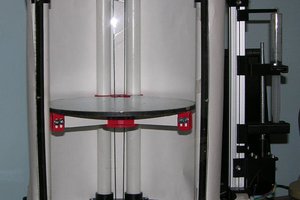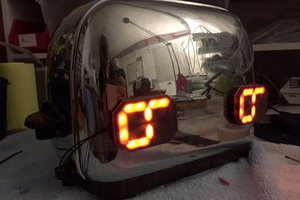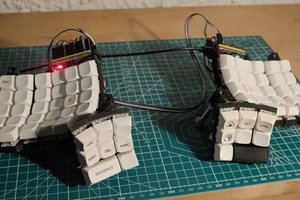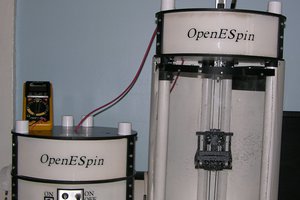Only 90s kids will appreciate the case's color scheme, which was everywhere from Wildberry Pop-Tarts to disposable Solo cups to the very awesome pair of roller blades I got in 1992.
Because key wells are swell.
To make the experience fit your profile, pick a username and tell us what interests you.
We found and based on your interests.
Only 90s kids will appreciate the case's color scheme, which was everywhere from Wildberry Pop-Tarts to disposable Solo cups to the very awesome pair of roller blades I got in 1992.
I just realized I never gave a final update. Well, semi-final update, because technically it's not finished, because only one half of it works.
After setting this project aside for several months, I am going to do a full continuity check and try to figure out what's going on. I may just replace the Pro Micro on the broken side (I did a dumb thing and didn't verify that the Pro Micros worked before using them).
All that's left are the TRRS jacks.
I can't even remember where I left off. Did I show you the rainbow row wiring on the right half? Because that's pretty much where I stopped.
Looks like I did, but none of it was soldered yet. Well now it's soldered, and it's still all stuck together in a rainbow. The problem is that I doubt it will fit inside the case like that. And that made me sad and/or scared to continue, and I stopped.
I've made the decision to just separate the damn wires and keep going.
I did more on this last night than I thought I would. I found the bag of diodes, bent the positive leg of each one into a loop, and soldered up half the keeb minus the thumb cluster (wasn't sure yet which way I wanted the switches to go (they have to be sideways)). Then I started playing around with rainbow ribbon cable to see how that might go.
I'm going to try to get a better picture of the pre-solder diode loops for when I finish filling out the instructions.
None of the wire is soldered yet, just doing a dry fit.
I was just about to order way more Kailh hot swap sockets than I need because it really is the ideal testing pad. But I really didn't want to pay essentially ~$12 for a single one and wait for a week plus.
I was just starting to breadboard the 4x4 practice matrix when it hit me. Breadboard guts! I tore the power rail off of a cruddy old breadboard and here we are.
Okay, so the prints are printed and the switches are lubed and re-sprung. Time to do the real work of turning it into a keyboard. But I'm not ready! So what needs to happen now?
I will tell you this: I have wanted automatic wire strippers for a long time, and I finally got some. They excel at stripping wire in the middle so you can wire up your switches like this instead of cutting a bunch of short wires. NOTE: the picture below is someone else's build.
The black set of keycaps showed up yesterday, and I couldn't resist trying them on. I think I still prefer purple thumb clusters.
Okay, so I've got half of the switches lubed and sprung, and I still need to open about 25 more switches and part them out into my ice cube tray.
I had bought a set of blank white PBT keycaps from the Bezos Barn for doing some artisan keycap experiments. Since they feel so nice and are only $21, I bought another set in black so I can combine the two and checkerboard everything but the thumb clusters. I went to order blank purple PBT 'caps from PMK for the thumb clusters, but they aren't taking new orders until July 1st. There's probably no way I will have this keeb ready for 'caps by then anyway.
And since I hate to post an update without a picture:

I'm doing two things to these Cherry browns -- lubing the business parts of the slider and its counterpart inside the housing, and replacing the springs.
Lots of people use Krytox, which is a somewhat expensive PTFE (Teflon)-based automotive lubricant. Super Lube is about 1/4 the price of Krytox. The brush is a 3/0 and is just a Michaels' store brand brush (Artist's Touch) that's about 1/8" wide. It fits quite satisfyingly inside the slider housing channels.
The new springs are 39g, which are lighter and shorter than the stock springs. I was going for lighter, and I'm just glad that shorter isn't an issue. Well, I won't really know that until it's built, but they actuate just fine in the lab.
Only ~50 more to go!
At this point, all four pieces are printed, but have not been fully cleaned up yet. Boy, a person can really spend a lot of time making prints look nice.
I have ordered and received most of the components, which reminds me that I need to update the components list.
I need to study up on key matrix theory and build a 'lil matrix on a breadboard before I wire this thing up. Does that deserve its own project? Sometimes I wish we could link projects together more obviously, or have space for sub-projects. I supposed I could make a Page for it instead.
Or have them printed at Shapeways. The pieces are pretty big, and I can say with confidence that they do not fit on a Lulzbot Mini's print bed. I printed these on a Lulzbot TAZ 6.
Create an account to leave a comment. Already have an account? Log In.
@W5VO please share progress! I would love to see how you do a flex PCB. I don't think you even need to pay for full flex - just thin substrate should do https://hackaday.io/project/171793-yet-another-dactyl-build/log/177938-bottoms-up/discussion-145468
Oh, that's exciting! I would agree with Simon, if only because the Kinesis Advantage PCBs aren't full flex.
I've seen that! Is there any chance you could measure the thickness of the Kinesis Advantage PCB? I don't work with thinner stuff so I don't have a good feel for how thin it would need to be.
@W5VO I use 0.6mm (but not for keyboards) and would estimate a bend radius of 50mm is achievable with 10mm wide strips so I'm sure it would be able to handle the key well curve for these keyboards. I'd hazard that you could use 0.8mm and don't forget the curve is a function of the width so you can vary the thickness of the connecting strips to make it bend more.
@W5VO @Simon Merrett I measured the Kinesis Advantage PCB at 0.44mm.
@kristina panos @Simon Merrett Thanks for that info! Once my switches come in, I think I'll be able to start mocking something up. The 0.4mm is maybe twice as much as the 0.6mm, but both are pretty affordable from the usual suspects in China.
I don't know why, but this reminds me of a 1950s diner. And "Bezos Barn", lol
Become a member to follow this project and never miss any updates

 Douglas Miller
Douglas Miller
 Sarah Petkus
Sarah Petkus
 David H. Bronke
David H. Bronke
I've been watching this project with great interest, and I just ordered the switches. You got some great feedback on printing the cases that I'll be reviewing. I think the only difference is that I'm going to see what it will take to make a flexible PCB for this layout of the Dactyl.